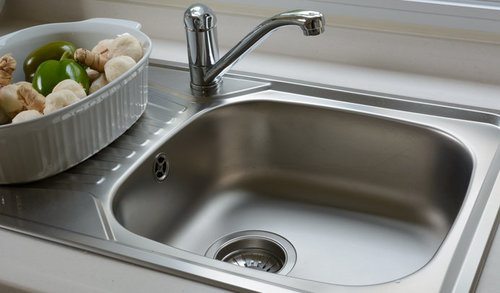Stainless Steel vs Porcelain Sink
Stainless Steel Sink
$250 - $450
(cost of a 31-inch stainless steel sink)
VS
Porcelain Sink
$250 - $500
(cost of a 31-inch porcelain enameled sink)
Cost to install a stainless steel or a porcelain kitchen sink varies greatly by region (and even by zip code).
To get free estimates from local contractors, please indicate yours.
Stainless Steel Sink

- Easier installation
- Contemporary styles available
- Many configurations and sizes available
- Lasts 15 - 30 years
- Less potential damage to household items
- Can contain 100% recycled material
- Easy to scratch
- May be loud or noisy
- No additional color choices
- Shows water spots
- No traditional styles/doesn’t complement traditional kitchens
- Higher maintenance
(cost of a 31-inch stainless steel sink)
Get free advice and estimates from kitchen designers in your city.
Porcelain Sink

- Many colors to choose from
- Quiet to use
- Lasts 25 - 30 years
- Low maintenance/can be refinished
- Many configurations and sizes available
- Lower maintenance
- May chip or crack with impact
- Heavy, more difficult installation
- May cause damage to household items
- Less easily recycled
- Fewer contemporary styles
(cost of a 31-inch porcelain enameled sink)
Get free advice and estimates from kitchen designers in your city.
Your kitchen sink gets a lot of use every day. It’s where you prepare for a meal and wash up after it’s done. It may also be the place you tend to plants, wash puppies and babies, or leave items to soak overnight.
Kitchen sinks come in a wide range of materials, as well as shapes, sizes, and styles. Two of the most popular options are stainless steel and porcelain enameled sinks, which may have a stainless steel or a cast iron base with a porcelain finish. Both of these sinks will make a great addition to your kitchen, but they look and function in different ways. We’ll compare the two below, so you can make a better determination of which will be better for your kitchen.
Appearance
While many porcelain sinks have a stainless steel interior, the two types of sinks couldn’t look more different from one another. True stainless steel sinks are made of steel that is either pressed into the shape of a sink or folded and welded into the shape of a sink. They can be very contemporary with clean lines and edges or they may have a more transitional appearance with rounded edges and a slightly rounded bottom. They come in several thicknesses, with thicker sinks having a more substantial look than thinner sinks. The steel may have a very bright, polished finish or they may have a wired brushed finish that can help hide scratches and water spots.
Porcelain sinks are much heavier and more substantial looking, because they’re made of either thick gauge cast iron or steel that has been coated in a baked-on porcelain enamel. This enamel can be very smooth or it may have a slightly undulating appearance to it. Porcelain sinks are most commonly white or cream in color, but you can special order them in a range of other colors as well to complement your home.
Both types of sinks come in several shapes and sizes, as well as in different configurations. Both can be drop in or undermounted, and both can be found in farmhouse or apron front styles as well. Overall, porcelain sinks have a more traditional appearance while stainless steel sinks have a more modern look, and work best in contemporary settings. Porcelain sinks can work in some modern settings, while they work best in traditional looks.
Installation
Installation of both sinks will vary depending on the type of countertop and the installation style of the sink. Both sinks are available in drop-in or self-rimming varieties, which means that the sinks can be installed by running a bead of adhesive around the edge of the countertop opening, and dropping the sink in.
Both sinks can also be installed in an undermount style, although this is more common for stainless steel; there are fewer undermount porcelain sinks available, mostly due to the size and weight of the sink.
In both cases, the sink is installed in the same way. The difference is in the amount of mounting hardware used; porcelain sinks are heavier and will require additional mounting hardware, so the installation will take longer than with a stainless steel sink of the same shape and size.
In both instances, a bead of adhesive is run around the underside of the sink opening, and the sink is placed against it. A C-clamp is run through the drain of the sink and holds it to the countertop, so that the sink can be secured while the adhesive cures.
Mounting hardware is epoxied to the underside of the countertop and the sink, and attached. Stainless sinks may have four to five mounting clips, while a porcelain sink will have nearly double to help hold their weight.
Costs
Both types of sinks have a range of associated costs based on size, configuration, and style.&
Stainless steel sinks start around $200 - $300 for a single bowl, undermount sink. Apron front sinks, sinks with multiple bowls, or contemporary styles can be more expensive, starting at $500 and going as high as $2,000 in some cases.
Enameled porcelain sinks also start around $200 - $300 for a single bowl sink in white. Prices begin to increase if you opt for another color, with some specialty colors costing considerably more - around $500 to $600 for the same sink. Costs may also increase for double bowl or apron front sinks, with some oversized cast iron enameled porcelain sinks cost around $1,000 - $1,500.
Installation costs for both types of sinks start around $50 for a drop-in sink. For undermount sinks, expect to pay around $150 for a stainless steel sink and $200 for a porcelain sink, for totals of $250 - $450 for a stainless steel sink installed and $250 - $500 for a porcelain sink installed.
Maintenance
Both sinks are fairly low maintenance materials. Stainless steel can scratch, so only non-abrasive cleaners should be used. If desired, you can also use a stainless steel cleaner. Sinks that have a brushed finish, rather than a mirror finish, are less likely to show scratches and water spots, while mirror finishes need to be dried after use with a soft cloth to prevent water stains from showing.
Porcelain sinks can be cleaned with nearly any material. The porcelain enamel is unlikely to scratch or stain, but if surface stains do occur, you can use a mild abrasive cleanser to remove them. Avoid using bleach or harsh chemicals on the sink, as this can break down the enamel over time.
Durability
For the most durable stainless steel sink, manufacturers usually recommend that the homeowner choose one with a lower gauge, meaning a thicker surface. However, a recent Consumer Reports guide differed from that opinion. In their findings, the specific gauge of the 18- to 23-gauge sinks that they tested had no effect on durability. Any of these are highly durable under many conditions. You would have to go to a 14- to 16-gauge sink to see a remarkable difference. It is wise, however, to choose a satin or brushed finish to avoid the inevitable small scratches that normal use will cause. A stainless steel sink is very unlikely to stain, but acids, bleach, and salt can cause pitting if left on the surface for a long period of time. Stainless steel is resistant to heat and most chemicals, which is why they are also the choice of most laboratory sinks.
A porcelain sink’s durability is due to its construction. Some sinks are solid porcelain, but the most durable have a steel or cast iron core covered with a baked-on porcelain finish. The key to maintaining that finish is to avoid scratches and chips in the porcelain that might expose the softer porcelain or even the metal beneath. Heavy or sharp objects dropped into the sink can cause this type of damage. Many homeowners use silicon pads or stainless steel racks inside the sink to protect the surface. You must also avoid allowing acidic substances to sit on the porcelain for an extended time since the porcelain stains easily. The nonporous porcelain finish also is resistant to heat. Over time, it may be necessary to have the sink refinished after the sink sustains serious staining, scratching, or chipping.
Both types of sinks have a long lifespan. A stainless steel sink will last 15 to 30 years, while a porcelain one will last 25 to 30 years or much longer, with the cast iron core sinks lasting longer than the steel ones. Porcelain sinks can be refinished to last the lifetime of the home itself. Also, the better each sink is maintained and cared for, the longer it will last.
Damage to Household Items
There is always a risk with any sink that dishes and glassware being washed in the sink may be broken. If items are dropped suddenly into a stainless steel sink, they are less likely to be broken or damaged than the same items dropped suddenly into an enameled porcelain sink. This is because the thinner stainless steel is able to absorb some of the vibration and movement of the drop, while the heavier porcelain sinks will not absorb as much of the shock, resulting in a broken dish or plate. Homeowners often report that they experience more glass breakage with porcelain sinks than with stainless steel ones.
Noise
Stainless steel sinks are thinner than porcelain enameled sinks, and they do vibrate when water or other items come in contact with the bottom. This vibration can mean that the sink tends to be noisy. To reduce this, most stainless steel sink manufacturers will put a pad or coating on the bottom of the sink to help muffle sound. Sinks without this pad, however, will be loud.
Porcelain enamel sinks are thicker and do not vibrate, so they tend to muffle sounds naturally and are overall a more quiet sink.
Environmental Concerns
Stainless steel is a recyclable material, and it is possible to purchase stainless steel sinks made of 100% recycled steel. In addition, many sink manufacturers make their sinks from raw recycled material. You do need to pay attention to the manufacturer, however, as not all sink manufacturers will use recycled material.
Porcelain over cast iron can also contain recycled material in the cast iron, sometimes up to 80 percent. It is more difficult to recycle this type of sink at the end of its lifespan, due to the porcelain coating, however, while a stainless steel sink can be recycled in its entirety.
Resale Value
Whether a sink is stainless steel or porcelain enameled, the most important element to consider on the resale value of a home is the condition of the sink. A stainless steel sink should be clean and free of scratches or water spots. Porcelain enamel sinks should have a glossy finish with no visible scratches or chips. Since stainless steel sinks do not chip or require refinishing, it may be the best choice for future resale value. However, because the porcelain enameled sink can be refinished, it is possible to help it maintain its value as well.
How much does it cost to install a stainless steel or a porcelain kitchen sink in my city?
Cost to install a stainless steel or a porcelain kitchen sink varies greatly by region (and even by zip code).
To get free estimates from local contractors, please indicate yours.